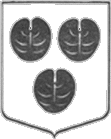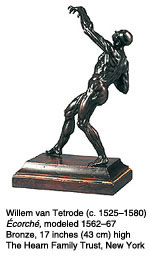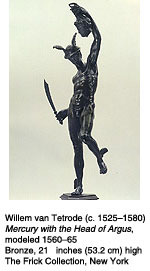
Willem van Tetrode (circa 1525 - 1580 of 1588):
Bronze Sculptures of the Renaissance
The Frick Collection, New York, and the
Rijksmuseum Amsterdam, Collaborate on Touring Exhibition
June 24 through September 7, 2003
|
The first exhibition devoted to one of the most innovative Dutch sculptors of the mid-sixteenth century ? who brought the tradition of the classically inspired Italian Renaissance bronze to the Netherlands ? is coming to The Frick Collection this summer. During almost twenty years in Italy, Willem van Tetrode (c. 1525-1580) studied and restored antique marble sculpture and worked for such 
celebrated artists as Benvenuto Cellini (1500-1571). From these experiences, he created expressive small bronzes showing the muscular male nude in poised or violent motion. Upon his return to Delft, Tetrode initiated a passion for collecting small bronzes in the North and inspired the muscular classicism in the work of younger artists, such as Hendrick Goltzius. Curated by Frits Scholten of the Rijksmuseum, Amsterdam, and co-organized by The Frick Collection, the exhibition presents almost forty of Tetrode's bronzes and an example of his marble sculpture in the skylighted Garden Court. A small Cabinet gallery installation exploring the relationship between the replicative arts of bronze casting and print-making will feature Tetrode's Striding Warrior and a small selection of prints by Goltzius, lent to the Frick by The Hearn Family Trust, as well as some results of the technical studies conducted for the exhibition. Willem van Tetrode (c. 1525-1580): Bronze Sculptures of the Renaissance is on view at The Frick Collection concurrently with The Metropolitan Museum of Art's showing of Hendrick Goltzius, Dutch Master (1558-1617): Drawings, Prints, and Paintings. Comments Denise Allen, Associate Curator of The Frick Collection, "Simultaneous presentations of these exhibitions, both of which originated at the Rijksmuseum, will offer New York audiences a valuable opportunity to explore the vital connections between the oeuvres of two artists who transformed their experience of Italian art into a powerful Northern idiom." This exhibition is made possible through the generosity of Henry R. Kravis, Melvin R. Seiden, Charles Hack and Angella Hearn, J. Tomilson Hill, Robert H. Smith, Julie and Lawrence Salander, Daniel Katz, Christie's, Cyril Humphris, Jon Landau, the Strong-Cuevas Foundation, and Patricia Wengraf, with additional support from the Fellows of The Frick Collection. HIGHLIGHTS Among the highlights of the exhibition is the presentation of a group of bronze statuettes that embellished the lost Pitigliano cabinet. Commissioned by Nicolò Orsini, Count of Pitigliano, as a diplomatic gift for the Spanish King, Philip II, the cabinet was the first of its kind to display a series of bronze reproductions of famous Roman antiquities. At the Frick, eleven of the twenty statuettes will be shown together, including the Farnese Hercules and the Medici Venus. His version of the latter is now considered the first reproduction of the paradigmatic antique marble, which helps to date the discovery in Rome of the Medici Venus to shortly before 1559, the year the cabinet was completed. 
The exhibition features individual masterpieces by Tetrode, such as the Écorché (Hearn Family Trust) and Bacchus (Fitzwilliam Museum). It also brings together variants of major bronzes not exhibited during the Amsterdam showing. For example, the Frick's version of Mercury is on view in New York along with another important cast from the Los Angeles County Museum of Art, as well as versions from the Rijksmuseum and the Bargello, Florence. Indeed, the Frick's showing of the exhibition presents for the first and probably only time all four major versions of this work, one of Tetrode's most significant and beautiful compositions. Also unique to the Frick venue is the display of a pair of large-scale bronzes showing nude men astride panthers. Almost unknown prior to their appearance on the art market last year, these impressive works have recently been associated with Tetrode.
Well over half of Tetrode's career was spent in Italy. His travels there as a young man reflected Italy's power to attract the most talented Northern artists who aspired to learn from its classical past and to gain employment at the forefront of the modern tradition. In Florence, Benvenuto Cellini first recognized Tetrode's abilities and employed the young man, known to Italians as Guglielmo Fiammingo (Willem the Fleming), as a marble carver between 1548 and 1551. Although nothing is known of Tetrode's training in the Netherlands, this early record indicates that he was fully conversant with marble before he turned to the medium of bronze. Tetrode carved the ornate marble base for Cellini's bronze Perseus (Florence, Piazza della Signoria). And, after leaving Florence, Tetrode also insisted that he, not Cellini, had restored an antique marble torso, transforming it into the Ganymede (Florence, Museo Nazionale del Bargello) that won Cellini fame as a master of marble carving. Ironically, this bitter denouement contained the seeds of Tetrode's future career as a modeler of all'antica bronze statuary. From Florence Tetrode traveled to Rome, seat of the classical past and home to the most active sculptural workshops in Italy. There, in 1551, Tetrode gained employment as a restorer of classical marble statues in the shop of Guglielmo della Porta (1504-1557), sculptor to the powerful Farnese family. In Rome, exciting discoveries of monumental antique marbles, like the Farnese Hercules in 1545, placed renewed emphasis on the dramatic muscular force of Hellenistic sculpture. Tetrode's response to this powerful strain of Hellenistic classicism was both immediate and long lasting. One of his first documented small bronzes, finished in 1559, is a much-reduced reproduction of the giant marble hero at rest. About five years later Tetrode would inventively energize this subject in one of his mature compositions, the Hercules Pomarius. Although as heavily muscled as his classical forebear, Tetrode's Hercules is, instead, poised for action. Edgily balanced on the balls of his feet, Hercules gazes sharply to the right and wields his heavy club as lightly as if it were a Roman short sword. In 1562, Tetrode went back to Florence, carrying a letter that declared him "truly outstanding in the art of sculpting and casting." There, he proved as attuned to the newest developments in contemporary art as he had been to classical sculpture. He very likely befriended Vincenzo de' Rossi (1525-1587), one of the city's leading sculptors, and was deeply influenced by his designs for twelve monumental marble figure groups illustrating the Labors of Hercules. The violent expressionism of Vincenzo's Hercules Battling the Centaur (Florence, Piazza della Signoria) may have inspired Tetrode's extraordinary bronze of the same subject. Shown during the height of their battle, at the climax of tension and collapse, Tetrode's twisting heroic nudes strain against each other with a muscular force that thrusts the centaur over the sculpture's base as his forelegs vainly scrabble for purchase in the empty air. Around 1565, compositions such as these prompted the art theoretician Gian Paolo Lomazzo to praise both Vincenzo de' Rossi and Tetrode as "two spirits who are truly divine." Tetrode's talent as a modeler in wax provided the link between the monumental marbles that he copied and restored and his original designs for bronze sculpture. Making a wax model was the sculptor's most direct, reliable means of generating accurate, small-scale replicas of over-life-size marble figures. Tetrode also depended on wax models as guides to restoring antiquities, for it was much easier to discern how to incorporate a missing head or limbs onto an antique fragment by working out the problem three dimensionally, in one's hands, using malleable wax. The same held true for designing an original composition. The wax model that served as Tetrode's locus of design was also the matrix for his finished sculptures, since plaster molds had to be taken from the wax models in order to produce finished casts in bronze. Tetrode's talent as a modeler in wax and his familiarity with bronze casting encouraged him to design sculptures of remarkable compositional freedom. Effortlessly spiraling figures such as the Mercury owned by The Frick Collection simultaneously evoke the pliability of wax and depend on the tensile strength of bronze. The existence of reusable molds also allowed for the replication of Tetrode's bronzes, and many of his compositions exist in multiple versions, some cast by later artists. RETURNING TO DELFT WITH A NEW VIEW OF CLASSICISM Tetrode returned to his native Delft in 1567, bringing with him the models he had produced after almost twenty years in Italy. To Netherlandish artists, collectors, and humanists, it was as if Italy's glorious classical and modern artistic achievements had been presented to them, in breathtaking combination, by a single hand. Tetrode's work inspired the great interest in small bronzes in the Italian manner that was to last for well over a century in the Netherlands. His aggressively muscular nudes helped inspire the younger Hendrick Goltzius's powerful brand of classicism. In all his sculptures, Tetrode memorably expressed the emotional power of the human figure as it was captured in muscular motion. But this ability is, perhaps, most movingly evinced in a late bronze that was intended as an anatomical model for his fellow artists. The Écorché unforgettably depicts a flayed man rearing back on his heels, each revealed muscle poised in tension, as he is almost miraculously suspended by the motion of his upswept arm. Later, Rubens was inspired to draw this bronze from three separate views, rendering the graceful pathos of the Écorché. The drawing captures the later master's own deeply felt experience of viewing Tetrode's sculpture. ILLUSTRATED PUBLICATION The exhibition is accompanied by a scholarly catalogue presenting new research by Scholten and other internationally recognized scholars. Essays include Emile van Binnebeke's reconstruction of Tetrode's lost Pitigliano cabinet and a technical study of his bronzes by Francesca Bewer, with contributions by Emile van Binnebeke, Robert van Langh, and Richard E. Stone. As Scholten points out, Tetrode emerges as a key figure in the artistic cross-fertilization between the Netherlands and Italy in the second half of the sixteenth century. The book (160 pages, 80 illustrations in full color, 70 in black and white), published in English by Waanders Uitgevers (nu Wbooks) in Zwolle, and the Rijksmuseum, Amsterdam, will be available in the Museum Shop of The Frick Collection, by phone at (212) 288-0700, and online through the institution's website (www.frick.org). FREE PUBLIC LECTURE Date: Wednesday, June 25, 2003, 6:00 pmSpeaker: Frits Scholten, the Rijksmuseum, Amsterdam Title: Willem van Tetrode, the First Modern Dutch Sculptor Willem van Tetrode was a crucial artist in bringing the Italian all'antica style to the Netherlands. This lecture will discuss the formation of his style and why he is considered such a modern artist. The focus will be on his life, work, reputation, and, to a lesser degree, his bronze casting technique. There is no charge for this lecture. Seating is unreserved and will be available beginning at 5:30 pm. RELATED EXHIBITION IN NEW YORK CITY Willem van Tetrode will be on view at The Frick Collection concurrently with the presentation at The Metropolitan Museum of Art of the touring exhibition Hendrick Goltzius, Dutch Master (1558-1617): Drawings, Prints, and Paintings (June 26 through September 7, 2003). This is the first major retrospective devoted to the virtuoso Netherlandish mannerist Hendrick Goltzius, and it will feature a selection of some 80 prints, 69 drawings, and 13 paintings, spanning the artist's entire career and demonstrating his legendary mastery of a remarkably wide range of media, subject matter, and styles.
General Information Phone: (212) 288-0700 Website: www.frick.org E-mail: info@frick.org Where: 1 East 70th Street, near Fifth Avenue. |